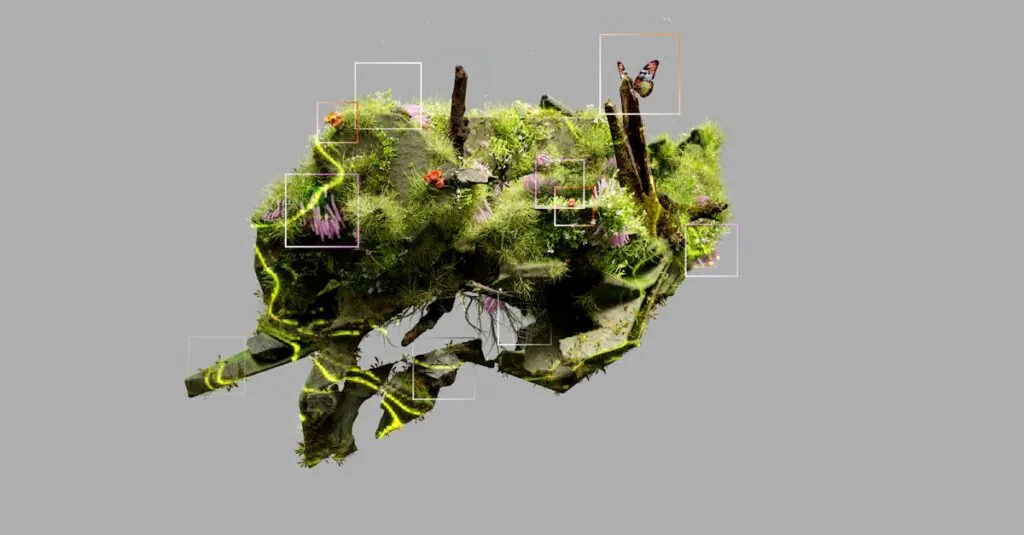In a world where every species is fighting for survival, artificial intelligence is stepping in like a superhero with a cape made of data. Imagine machines that can identify endangered species faster than a cheetah on roller skates. AI’s got the potential to revolutionize how we protect our planet’s biodiversity, and it’s not just a pipe dream—it’s happening now.
Overview of AI for Biodiversity
Artificial intelligence plays a crucial role in biodiversity conservation. Researchers leverage AI to monitor ecosystems and manage wildlife populations effectively. These technologies analyze data from various sources, including satellite imagery and audio recordings. By processing vast amounts of information, AI can detect changes in habitats and identify species more rapidly than traditional methods.
Machine learning algorithms enhance species identification by recognizing patterns in biological data. Tools like computer vision and deep learning enable real-time analysis of images, allowing conservationists to track endangered species. Unmanned aerial vehicles equipped with AI gather data from remote areas, ensuring comprehensive monitoring of habitats.
AI also aids in predicting and mitigating the impacts of climate change. It enables the modeling of ecological scenarios, helping policymakers make informed decisions about conservation strategies. By simulating various parameters, AI identifies the most effective interventions for preserving biodiversity.
Furthermore, AI enhances public engagement in conservation efforts. Applications that invite citizen participation in data collection promote awareness and encourage community involvement. Platforms utilizing AI enable individuals to report wildlife sightings, contributing valuable information to conservation databases.
Innovations in AI continue to emerge, driving progress in biodiversity protection. Technologies that utilize blockchain for secure data sharing are gaining traction, facilitating collaboration among conservation organizations. As AI systems evolve, they promise to address the challenges facing biodiversity more effectively than ever.
Applications of AI in Conservation
AI technology revolutionizes biodiversity conservation through various applications. These advancements enhance efforts to protect endangered species and monitor ecosystems effectively.
Species Identification
AI accelerates species identification by analyzing images and audio recordings. Researchers employ machine learning algorithms to differentiate between species with high accuracy. These algorithms recognize subtle differences in physical traits and behaviors, improving monitoring of endangered populations. Tools like computer vision enable real-time species identification from pictures collected in the field. Additionally, mobile applications allow citizen scientists to contribute by uploading wildlife sightings, expanding data collection efforts. The combination of AI and citizen involvement fosters greater awareness about species preservation.
Habitat Monitoring
AI enhances habitat monitoring through satellite imagery analysis and drone technology. Unmanned aerial vehicles capture high-resolution images of landscapes, enabling detection of changes in vegetation and land use. This approach allows researchers to analyze ecosystem health quickly. AI algorithms can process vast datasets to identify patterns indicating habitat degradation or species migration. Predictive modeling tools simulate environmental changes, assisting conservationists in understanding potential threats. By facilitating continuous monitoring, AI plays a crucial role in maintaining biodiversity and informing conservation strategies.
Benefits of AI for Biodiversity
AI offers substantial benefits for biodiversity conservation, enhancing efficiency and effectiveness in various approaches.
Enhanced Data Analysis
Advanced data analysis capabilities set AI apart in biodiversity conservation. Researchers deploy AI to sift through vast datasets generated from satellite imagery and audio recordings. These algorithms identify species and habitat changes rapidly, surpassing traditional methods. Through machine learning, AI discerns intricate patterns in biological data, providing actionable insights. Real-time image analysis tools improve accuracy in species identification, allowing for timely interventions. Notably, citizen science apps also leverage AI, encouraging community participation in data collection, which amplifies the available dataset. In summary, AI transforms data analysis, leading to improved monitoring and conservation efforts.
Predictive Modeling
Predictive modeling plays a crucial role in AI’s impact on biodiversity. Machine learning techniques create ecological scenario models that forecast climate change impacts. These models help conservationists anticipate potential threats to various species and ecosystems. By simulating different environmental conditions, AI assists policymakers in crafting informed conservation strategies. Additionally, predictive tools analyze historical data, identifying trends and risks that may affect biodiversity over time. As a result, these insights empower proactive measures that safeguard diverse ecosystems and species at risk. AI’s predictive modeling capabilities thus bolster conservation efforts on multiple fronts.
Challenges in Implementing AI for Biodiversity
Implementing AI for biodiversity faces significant challenges that can impede conservation efforts.
Data Quality and Accessibility
Data quality poses a major hurdle; inaccuracies in datasets can lead to flawed AI analyses. Researchers rely on accurate and comprehensive data to inform their models. Limited access to high-quality ecological information often restricts the effectiveness of AI. Collaboration across sectors can enhance data sharing, although proprietary restrictions complicate this process. Various stakeholders, including governments, NGOs, and private sectors, play crucial roles in ensuring data quality. A unified approach towards data collection methodologies can streamline efforts, ultimately improving AI applications in biodiversity conservation.
Ethical Considerations
Ethical considerations remain paramount in the deployment of AI for biodiversity. Concerns around privacy and the potential misapplication of technology often arise. Decision-makers must balance the benefits of AI implementation with ethical implications for wildlife and stakeholders. Transparency in AI algorithms can foster trust, while accountability mechanisms ensure responsible use. Engaging local communities in decision-making processes enhances ethical practices, supporting both conservation goals and community welfare. Continuous dialogue among scientists, ethicists, and the public can address these challenges proactively.
Future Directions in AI for Biodiversity
Artificial intelligence continues to evolve, promising exciting advancements in biodiversity conservation. Enhancements in data processing capabilities will allow AI systems to analyze vast amounts of ecological data more efficiently. Improved algorithms for machine learning will refine species identification methods, leading to higher accuracy in real-time applications. Researchers are likely to leverage AI’s predictive modeling to anticipate ecological changes more effectively, thus aiding conservation strategies.
Integration of AI with citizen science initiatives is another promising avenue. New mobile applications will facilitate the collection of wildlife sightings from volunteers, which will expand data sets significantly. These platforms will also enhance user engagement, encouraging further participation in conservation efforts. Innovations in remote sensing technology will enable drones and satellites to monitor habitats at unprecedented scales, providing continual updates on ecosystem health.
Collaboration among stakeholders is essential for overcoming current challenges. Partnerships between technology developers, conservationists, and local communities can drive efforts to improve data quality and accessibility. Ethical AI usage must remain a core focus, ensuring transparency in algorithms and protecting wildlife interests. Engaging communities in decision-making processes will cultivate responsible conservation practices.
Finally, ongoing research in AI for biodiversity will likely emphasize climate change mitigation. By modeling potential scenarios, AI can support proactive measures to shield threatened ecosystems and species. As developments progress, the integration of blockchain for data sharing will enhance security and trust among participants in conservation efforts. Through these future directions, AI stands poised to transform biodiversity conservation significantly.
AI’s integration into biodiversity conservation represents a pivotal shift in how ecosystems are monitored and protected. By leveraging advanced technologies and data analysis, it’s possible to identify endangered species and assess habitat changes more efficiently than ever before. The collaboration between scientists and citizen engagement enhances data collection and raises awareness about conservation efforts.
As AI continues to evolve, its potential to address pressing environmental challenges will only grow. Future innovations promise to refine species identification and predictive modeling further, ensuring that conservation strategies are both effective and sustainable. Embracing these advancements while navigating ethical considerations will be crucial in the ongoing fight to preserve biodiversity for generations to come.





